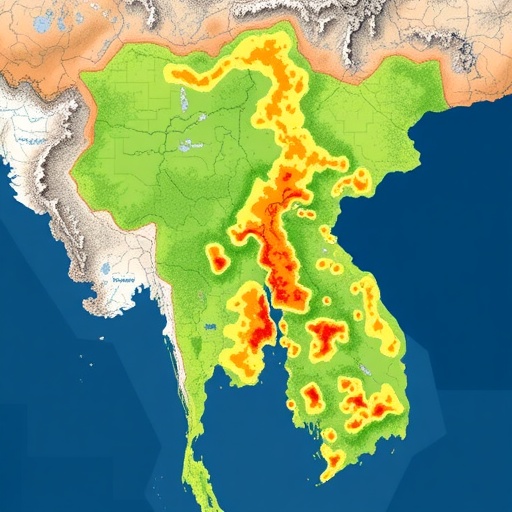Geospatial Analysis Enhances Poultry-Fish Farming in Myanmar – Bioengineer.org

Report on Integrated Poultry-Fish Farming in Myanmar: A Geospatial Approach to Achieving Sustainable Development Goals
Introduction
A study conducted by Belton et al. details the application of geospatial analysis for monitoring integrated poultry and fish farms in Myanmar. This report examines the study’s findings, emphasizing their direct contributions to several United Nations Sustainable Development Goals (SDGs). The research presents an innovative framework for enhancing agricultural resilience and sustainability in economically and environmentally fragile regions, aligning with the global 2030 Agenda for Sustainable Development.
Advancing Sustainable Agriculture and Food Security (SDG 2: Zero Hunger)
The core of the research directly addresses SDG 2 by promoting sustainable agriculture and improving food security for vulnerable populations. The integrated farming model offers a pathway to end hunger and ensure access to safe, nutritious food.
Key Contributions to SDG 2
- Enhanced Productivity: The synergistic relationship, where poultry waste fertilizes fish ponds, increases the yield of both poultry and fish, directly boosting food production.
- Resilient Agricultural Practices: By leveraging geospatial technology, farmers can implement more resilient practices that withstand climatic fluctuations and market pressures, ensuring stable food supplies (Target 2.4).
- Support for Smallholder Farmers: The study provides smallholder farmers with tools and knowledge to increase their agricultural productivity and incomes, a key component of Target 2.3.
Fostering Economic Growth and Reducing Poverty (SDG 1: No Poverty & SDG 8: Decent Work and Economic Growth)
The economic implications of integrated farming are significant, offering a viable strategy for poverty alleviation and promoting sustained, inclusive economic growth.
Economic Benefits and SDG Alignment
- Income Diversification: The dual production of poultry and fish provides farmers with multiple income streams, reducing their vulnerability to market volatility and mitigating economic risks, thereby contributing to poverty reduction (SDG 1).
- Sustainable Livelihoods: By creating a more productive and stable farming system, the model secures livelihoods for rural communities and contributes to the broader local economy (SDG 8).
- Increased Resilience: Enhanced economic resilience allows farmers to better withstand shocks, breaking cycles of poverty and fostering long-term financial stability.
Promoting Responsible Consumption and Production and Climate Action (SDG 12, SDG 13, SDG 14, SDG 15)
The integrated system exemplifies principles of a circular economy and responsible resource management, leading to significant environmental benefits and enhanced climate resilience.
Environmental Stewardship and Sustainability
- Responsible Production (SDG 12): The model maximizes resource efficiency by converting waste (poultry excrement) into a valuable resource (fertilizer), minimizing the overall ecological footprint of farming operations.
- Protecting Ecosystems (SDG 14 & SDG 15): By reducing nitrogen and phosphorus runoff into local waterways, the system improves water quality, protecting aquatic life (SDG 14) and promoting the sustainable use of terrestrial ecosystems (SDG 15).
- Climate Action (SDG 13): The research offers a model for developing resilient agricultural systems that can adapt to the adverse impacts of climate change, strengthening the capacity of farming communities to manage climate-related hazards.
Leveraging Innovation and Partnerships for the Goals (SDG 9: Industry, Innovation, and Infrastructure & SDG 17: Partnerships for the Goals)
The successful implementation and scaling of this model depend on technological innovation and robust collaboration among stakeholders, reflecting the principles of SDG 9 and SDG 17.
Framework for Implementation
- Technological Innovation (SDG 9): The use of sophisticated geospatial analysis, satellite imagery, and Geographic Information Systems (GIS) represents a significant technological advancement in agriculture, fostering innovation to solve pressing food security challenges.
- Multi-Stakeholder Partnerships (SDG 17): The study underscores the need for effective partnerships between farmers, researchers, and policymakers. Success requires:
- Supportive government policies and investment in infrastructure.
- Community engagement and training programs to build local capacity.
- Collaboration to ensure scientific research translates into practical, on-the-ground applications.
Conclusion
The research by Belton et al. provides a compelling, evidence-based model for sustainable agriculture that simultaneously addresses multiple SDGs. The integration of poultry and fish farming, enabled by geospatial technology, offers a scalable solution for enhancing food security, reducing poverty, and promoting environmental stewardship in Myanmar and other fragile states. This approach serves as a powerful example of how targeted innovation and strategic partnerships can accelerate progress toward a sustainable and food-secure future for all.
Analysis of Sustainable Development Goals in the Article
1. Which SDGs are addressed or connected to the issues highlighted in the article?
- SDG 2: Zero Hunger: The article’s central theme is enhancing food security and promoting sustainable agriculture in Myanmar through integrated poultry and fish farming. It directly addresses the need for increased food production and resilient farming practices.
- SDG 8: Decent Work and Economic Growth: The study highlights how integrated farming diversifies farmers’ income streams, enhances their resilience against market fluctuations, and contributes to their livelihoods and the broader economy.
- SDG 9: Industry, Innovation, and Infrastructure: The research is based on the application of innovative methods like advanced geospatial technologies, satellite imagery, and Geographic Information Systems (GIS) to improve agricultural practices. It also calls for investment in infrastructure to support these new methods.
- SDG 12: Responsible Consumption and Production: The article emphasizes resource efficiency and waste reduction. The integrated system where poultry excrement is used as fertilizer for fish ponds is a clear example of sustainable production patterns.
- SDG 13: Climate Action: The article discusses the need for adaptable and resilient farming techniques that can withstand “climatic fluctuations” and serve as a model for developing resilient agricultural systems in the face of climate change.
- SDG 14: Life Below Water: The environmental benefits of the integrated system are noted, specifically the “reduction of nitrogen and phosphorus runoff from farms into local waterways,” which leads to improved water quality and protects aquatic ecosystems.
2. What specific targets under those SDGs can be identified based on the article’s content?
-
SDG 2: Zero Hunger
- Target 2.3: By 2030, double the agricultural productivity and incomes of small-scale food producers. The article focuses on smallholder farmers in Myanmar and discusses how integrated farming leads to “increased yields” and “diversifies farmers’ income streams.”
- Target 2.4: By 2030, ensure sustainable food production systems and implement resilient agricultural practices that increase productivity and production. The article describes the integrated poultry-fish farming model as a “sustainable and productive” system that helps farmers “withstand climatic fluctuations and market pressures.”
-
SDG 8: Decent Work and Economic Growth
- Target 8.2: Achieve higher levels of economic productivity through diversification, technological upgrading and innovation. The article explicitly mentions that the “dual production of poultry and fish… diversifies farmers’ income streams” and highlights the use of “advanced geospatial technologies” to optimize farm management.
-
SDG 9: Industry, Innovation, and Infrastructure
- Target 9.5: Enhance scientific research, upgrade the technological capabilities of industrial sectors in all countries. The study itself is an example of applying scientific research (geospatial analysis) to upgrade the agricultural sector in Myanmar. It calls for encouraging “collaboration between farmers, researchers, and policymakers.”
-
SDG 12: Responsible Consumption and Production
- Target 12.2: By 2030, achieve the sustainable management and efficient use of natural resources. The article details how the integrated system “enhances resource efficiency,” for example, by using “poultry excrement… as an organic fertilizer for fish ponds,” thus maximizing resource utilization.
-
SDG 14: Life Below Water
- Target 14.1: By 2025, prevent and significantly reduce marine pollution of all kinds, in particular from land-based activities, including nutrient pollution. The article directly addresses this by stating that the integrated system leads to a “reduction of nitrogen and phosphorus runoff from farms into local waterways,” which improves water quality.
3. Are there any indicators mentioned or implied in the article that can be used to measure progress towards the identified targets?
-
For Target 2.3 (Double productivity and incomes):
- Implied Indicator: Change in agricultural yields (poultry and fish). The article mentions “increased yields” as a benefit.
- Implied Indicator: Change in farmer income. The article states the system “diversifies farmers’ income streams” and enhances “resilience against market fluctuations.”
-
For Target 2.4 (Sustainable and resilient practices):
- Implied Indicator: Rate of adoption of integrated farming systems by local farmers. The article emphasizes the importance of “community engagement and education” for successful implementation.
- Implied Indicator: Measurement of waste reduction. The article points to “reduced waste” as a key benefit of the synergistic system.
-
For Target 12.2 (Efficient use of natural resources):
- Implied Indicator: Percentage of agricultural waste (e.g., poultry excrement) recycled or reused within the farming system. The article highlights this as a core component of the integrated model’s resource efficiency.
-
For Target 14.1 (Reduce nutrient pollution):
- Mentioned Indicator: Levels of nitrogen and phosphorus in local waterways. The article explicitly mentions the “reduction of nitrogen and phosphorus runoff” as an environmental benefit that leads to “improved water quality.”
4. Table of SDGs, Targets, and Indicators
| SDGs | Targets | Indicators |
|---|---|---|
| SDG 2: Zero Hunger | 2.3: Double the agricultural productivity and incomes of small-scale food producers. 2.4: Ensure sustainable food production systems and implement resilient agricultural practices. |
– Increased agricultural yields (poultry and fish). – Diversification of farmer income streams. – Rate of adoption of integrated farming systems. |
| SDG 8: Decent Work and Economic Growth | 8.2: Achieve higher levels of economic productivity through diversification and technological upgrading. | – Number of farmers with diversified income sources. – Adoption rate of geospatial technologies in farm management. |
| SDG 9: Industry, Innovation, and Infrastructure | 9.5: Enhance scientific research and upgrade technological capabilities. | – Number of farmers trained in using geospatial analysis tools. – Investment in agricultural technology and research. |
| SDG 12: Responsible Consumption and Production | 12.2: Achieve the sustainable management and efficient use of natural resources. | – Percentage of agricultural by-products (e.g., poultry waste) reused. – Measurement of overall resource efficiency on farms. |
| SDG 14: Life Below Water | 14.1: Prevent and significantly reduce marine pollution, including nutrient pollution. | – Measured reduction in nitrogen and phosphorus levels in local waterways. |
Source: bioengineer.org
What is Your Reaction?
 Like
0
Like
0
 Dislike
0
Dislike
0
 Love
0
Love
0
 Funny
0
Funny
0
 Angry
0
Angry
0
 Sad
0
Sad
0
 Wow
0
Wow
0
















































/environment-climate-change-and-health-(ech)/water-sanitation-hygiene-and-health-(wsh)/landfill-tuvalu-36092.tmb-1200v.jpg?sfvrsn=5c21fe40_1#)

.jpg.webp?itok=0ZsAnae9#)























